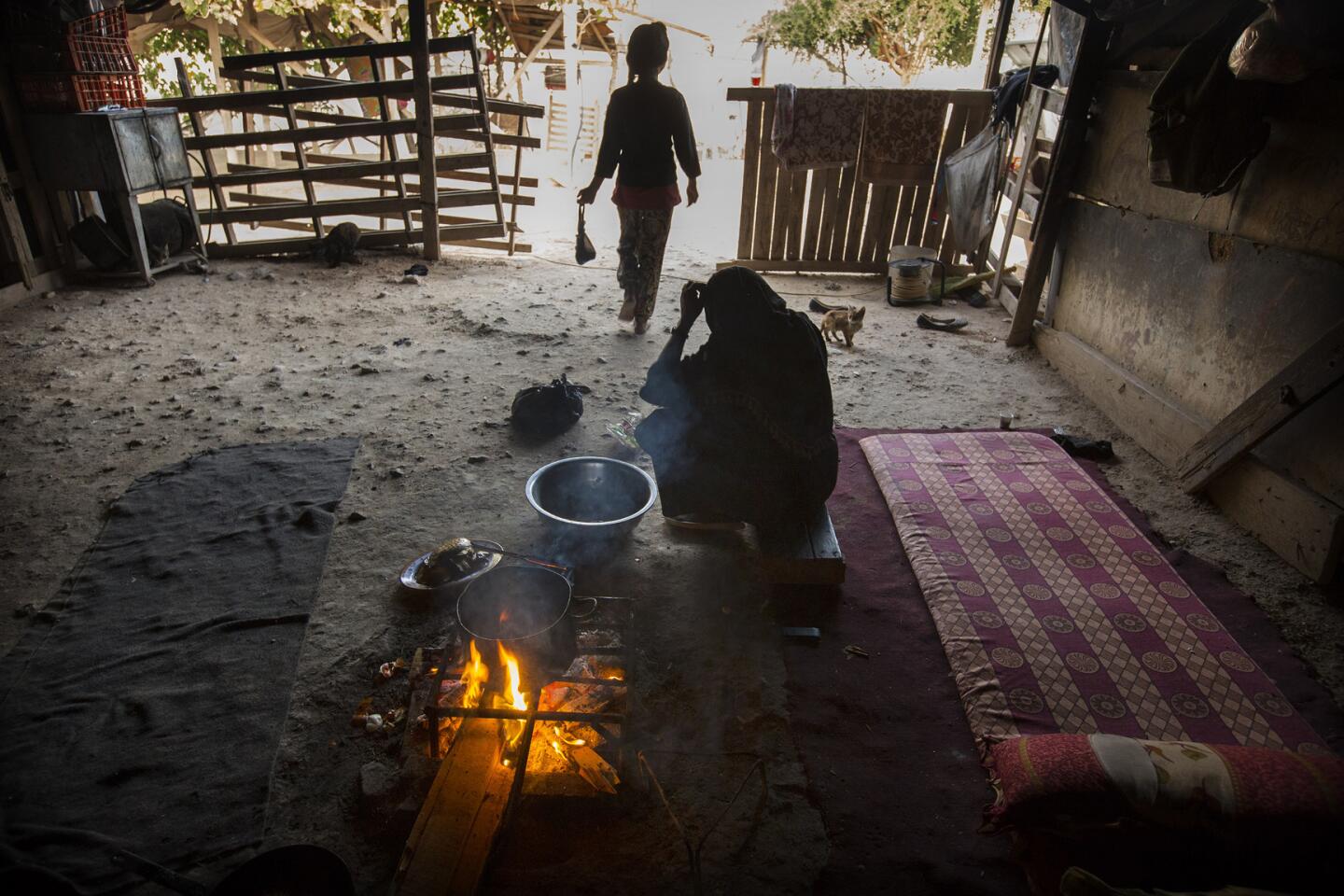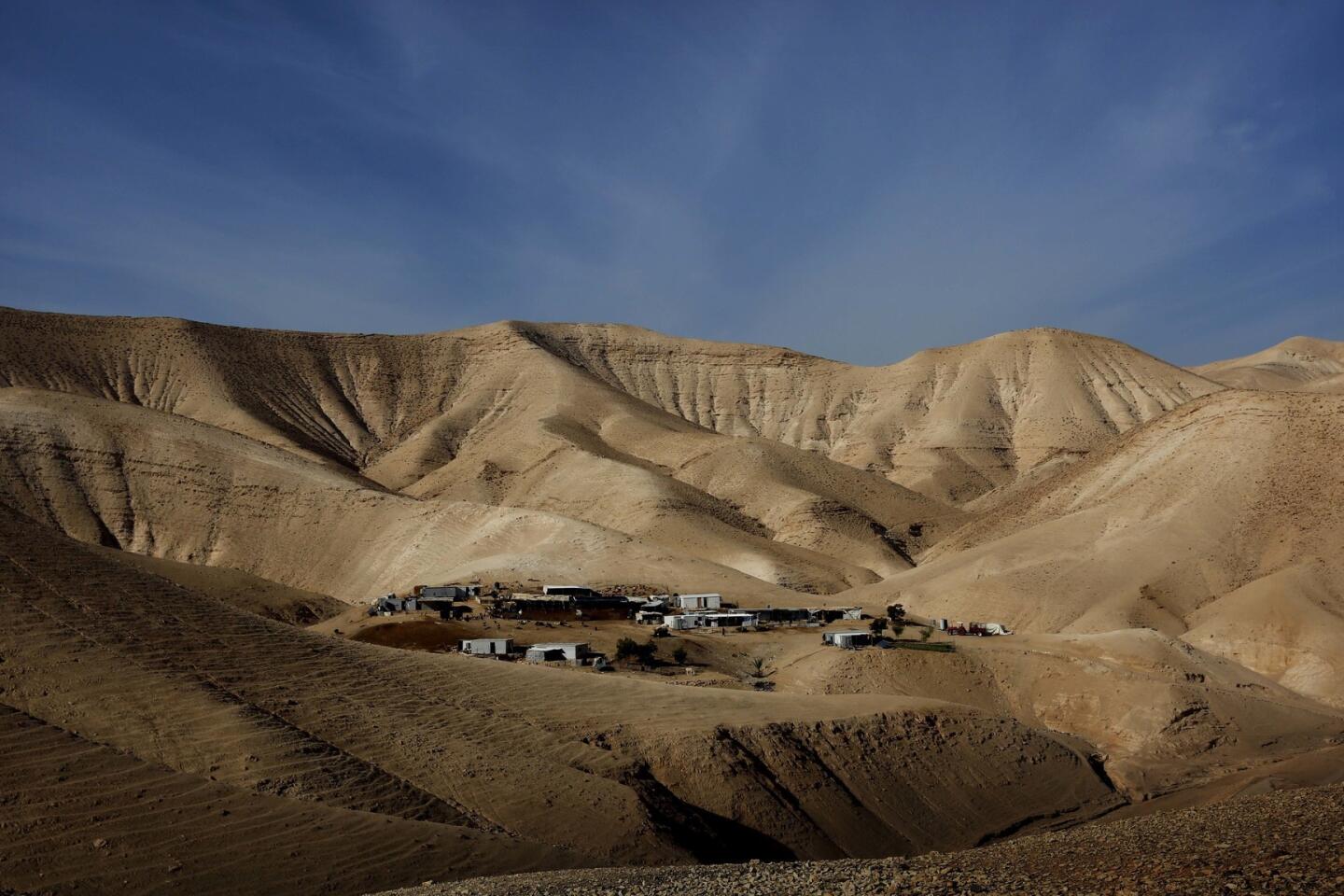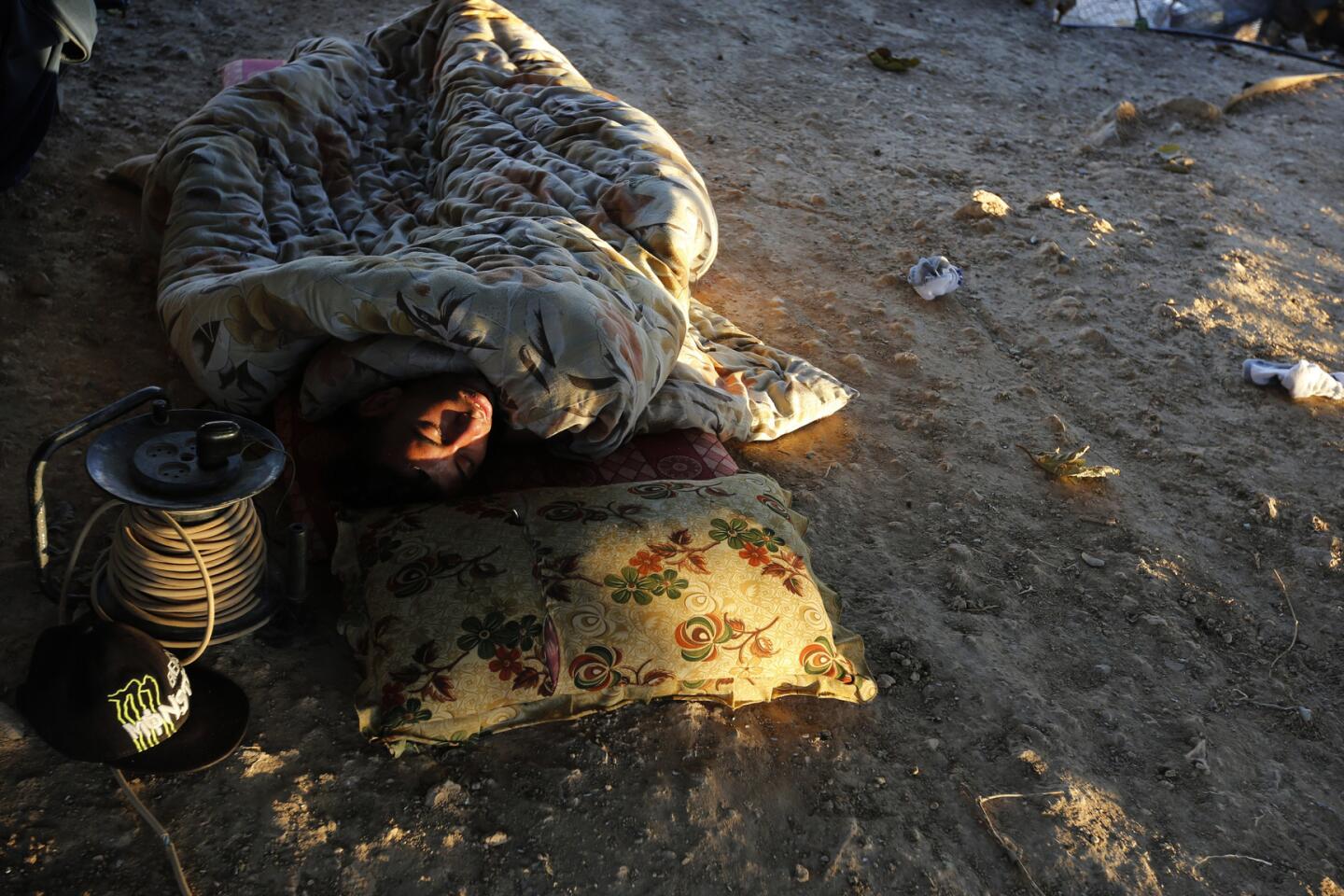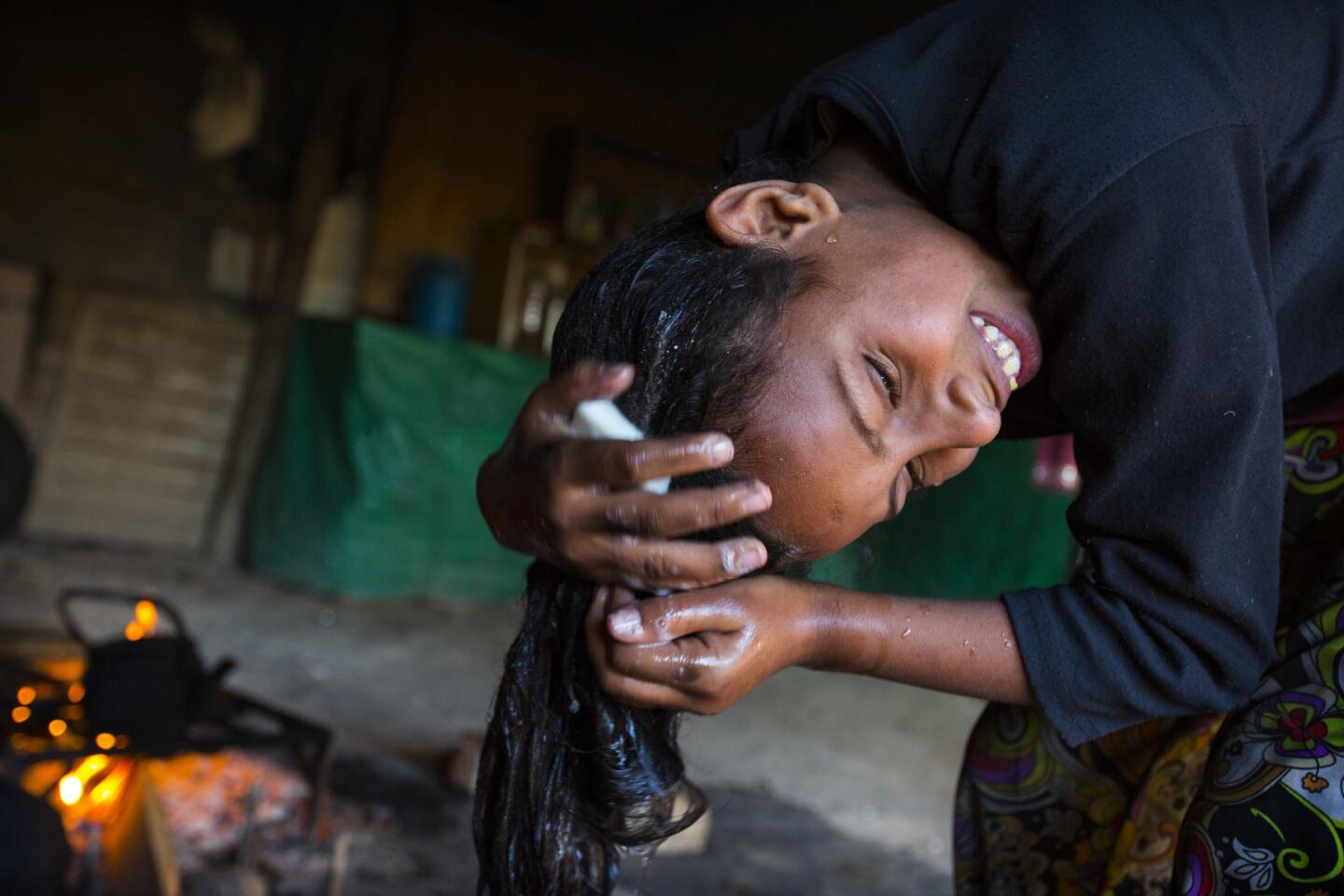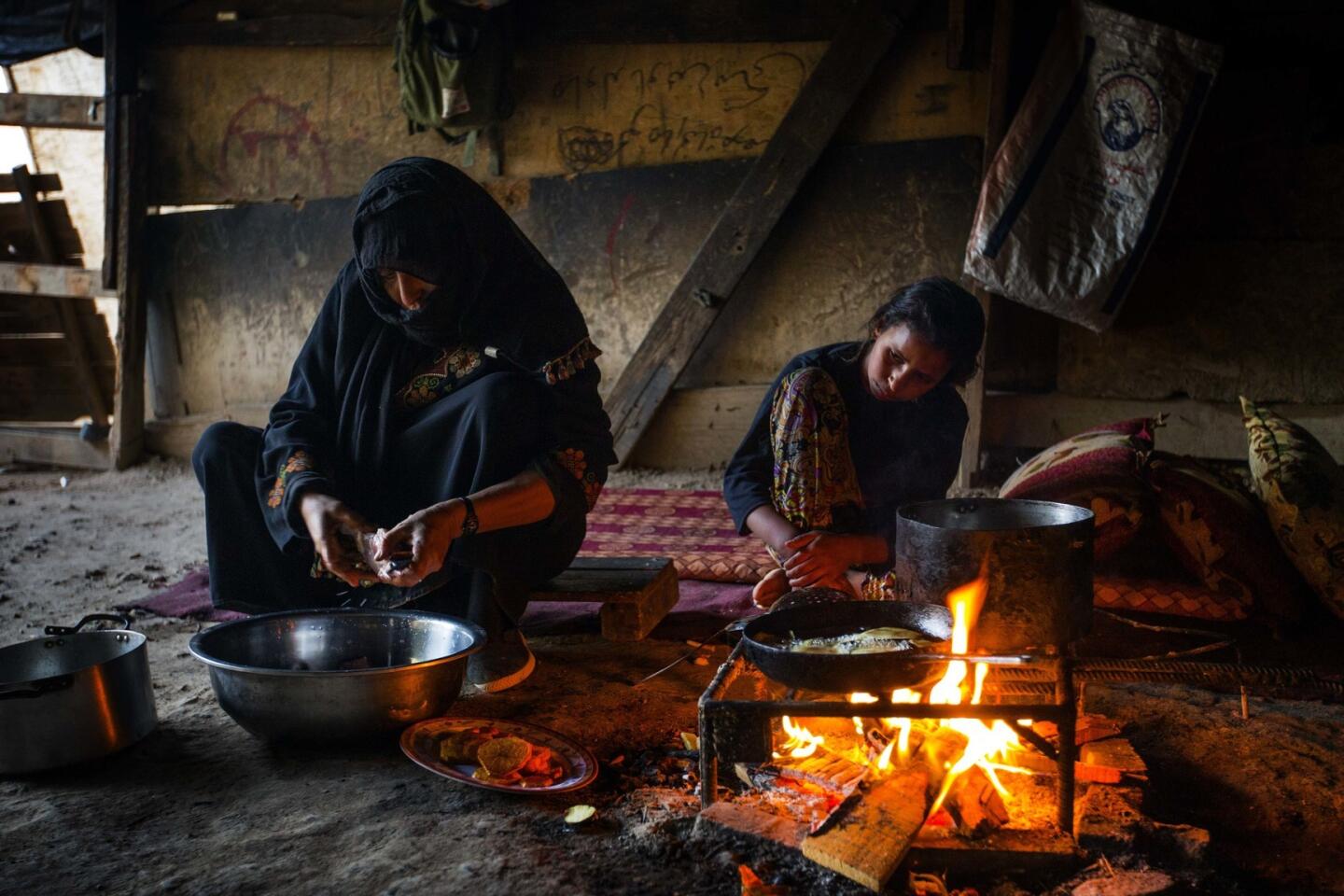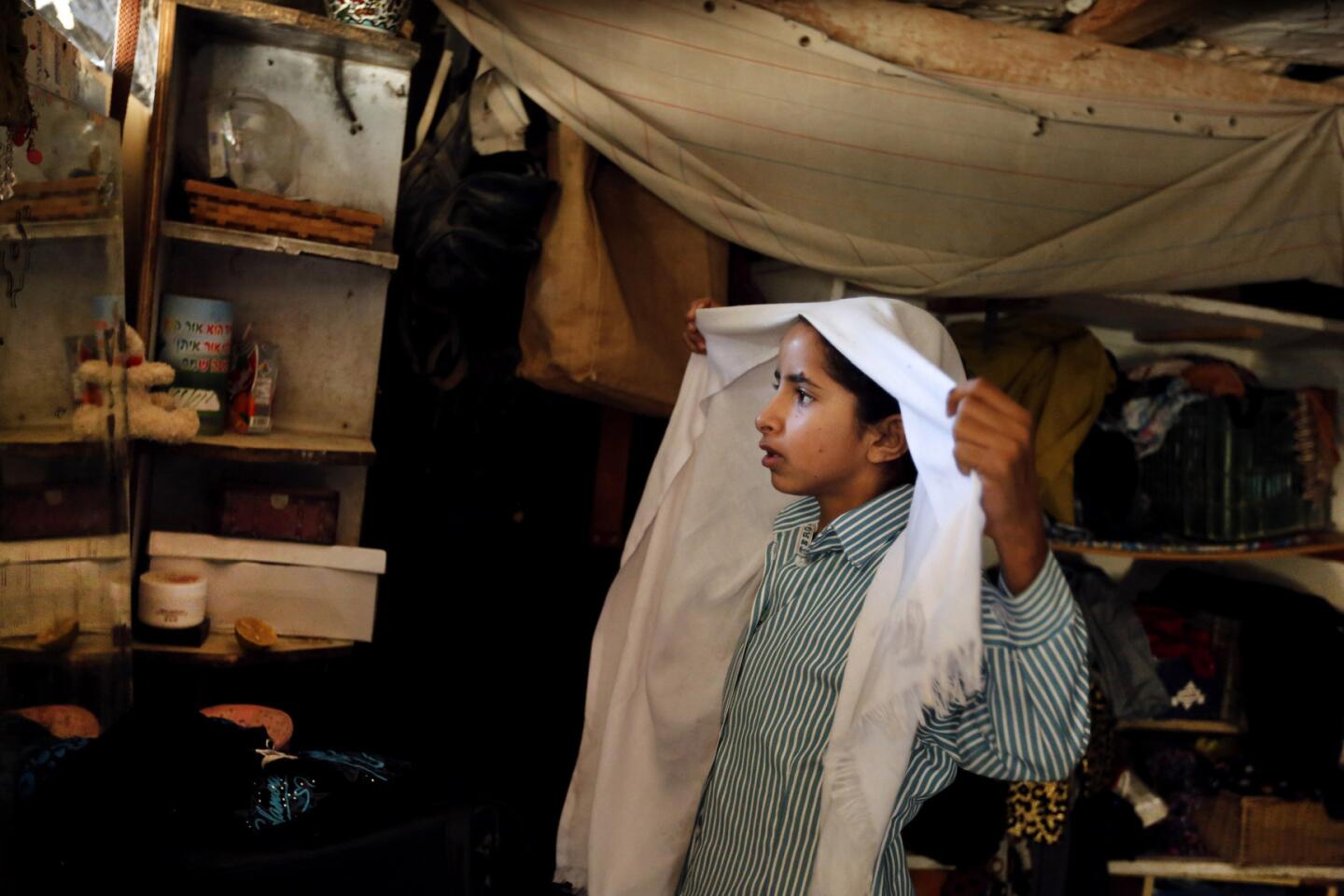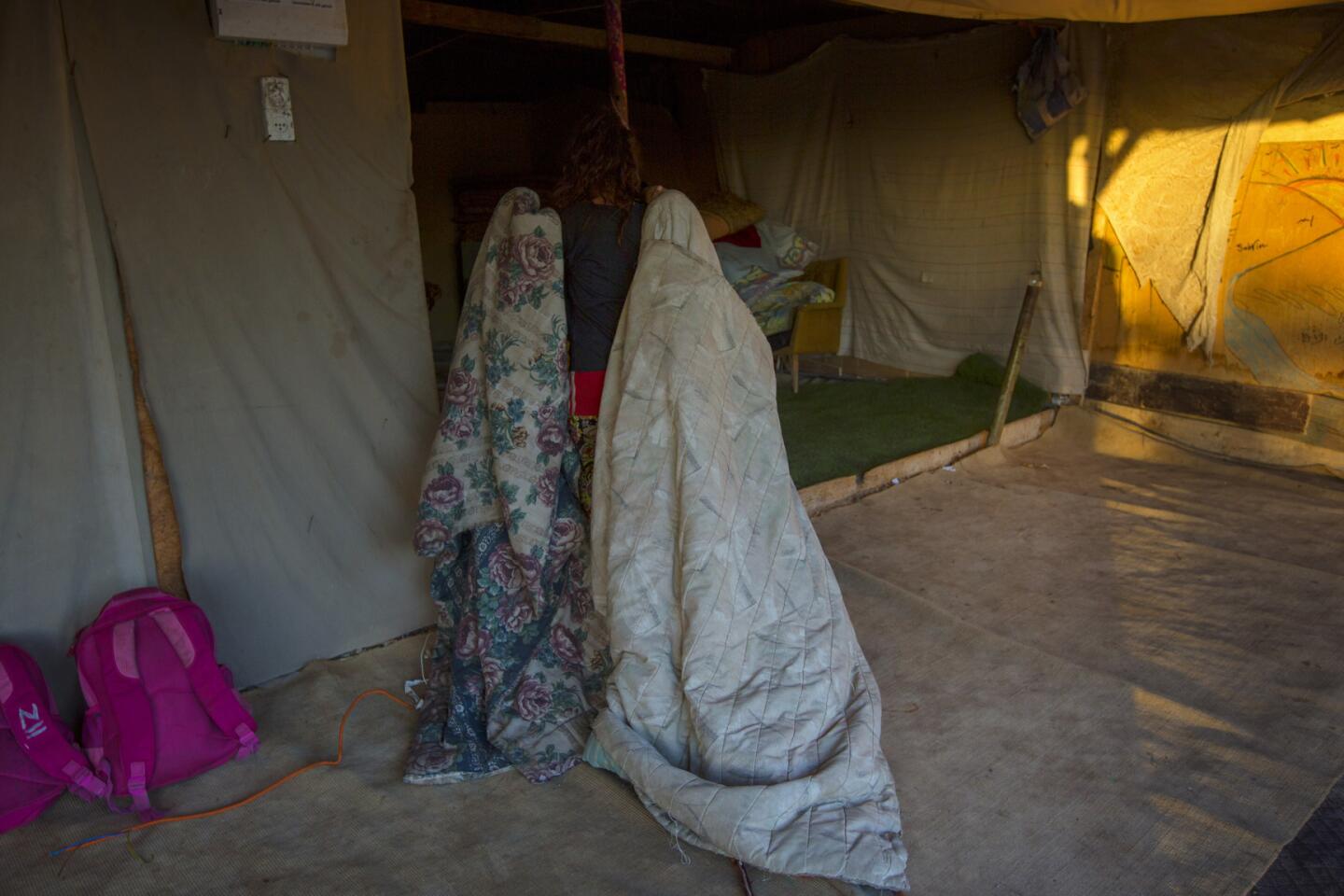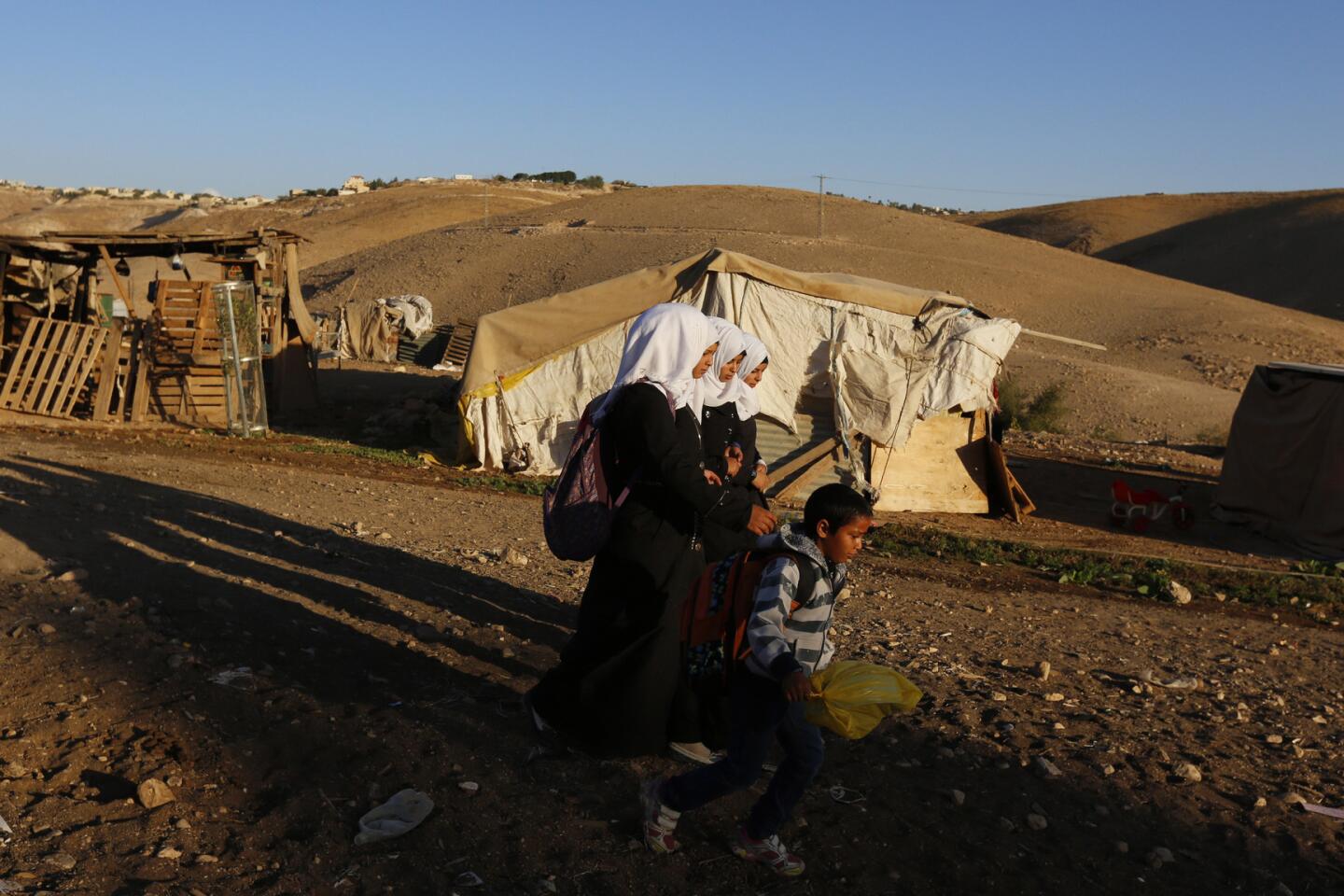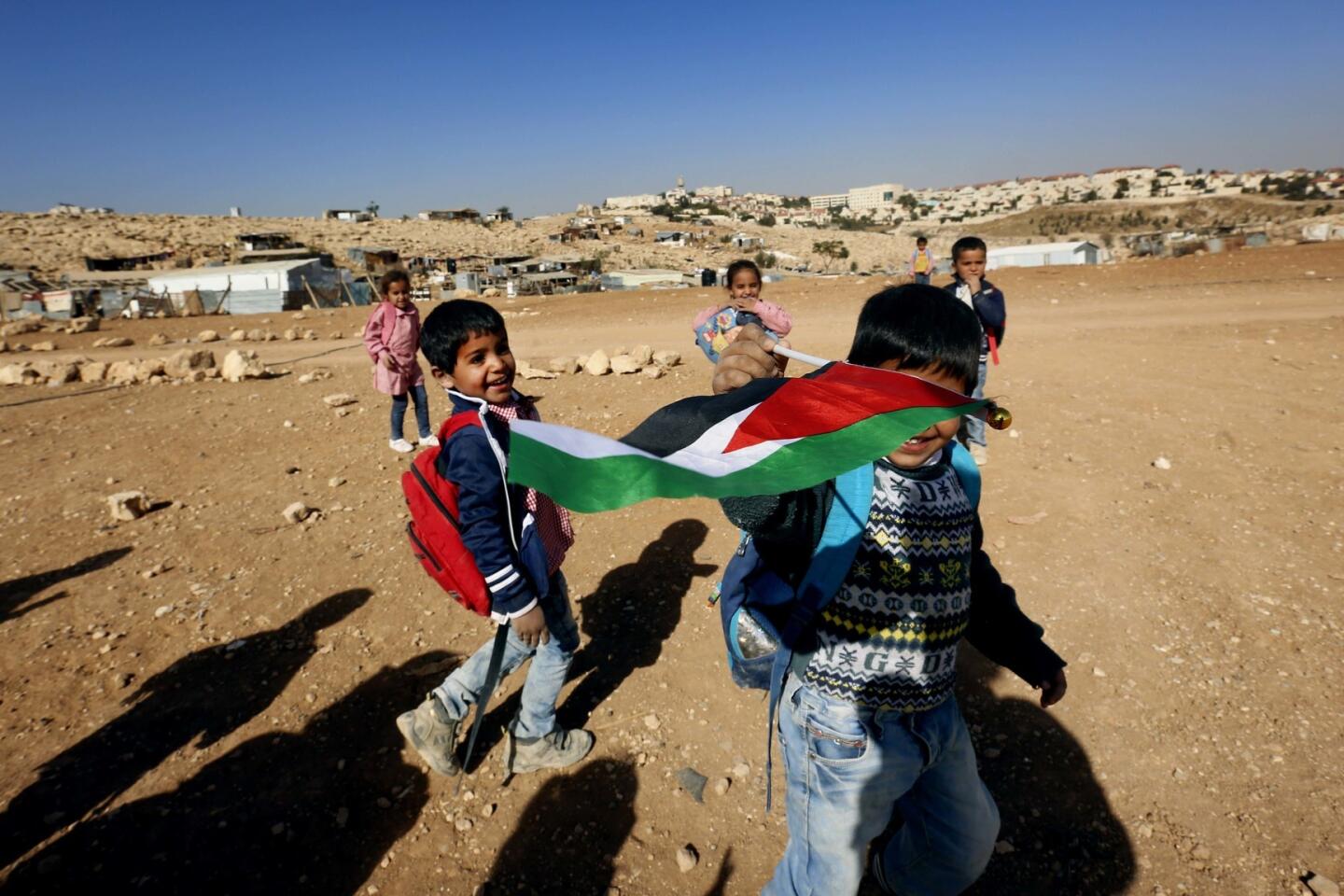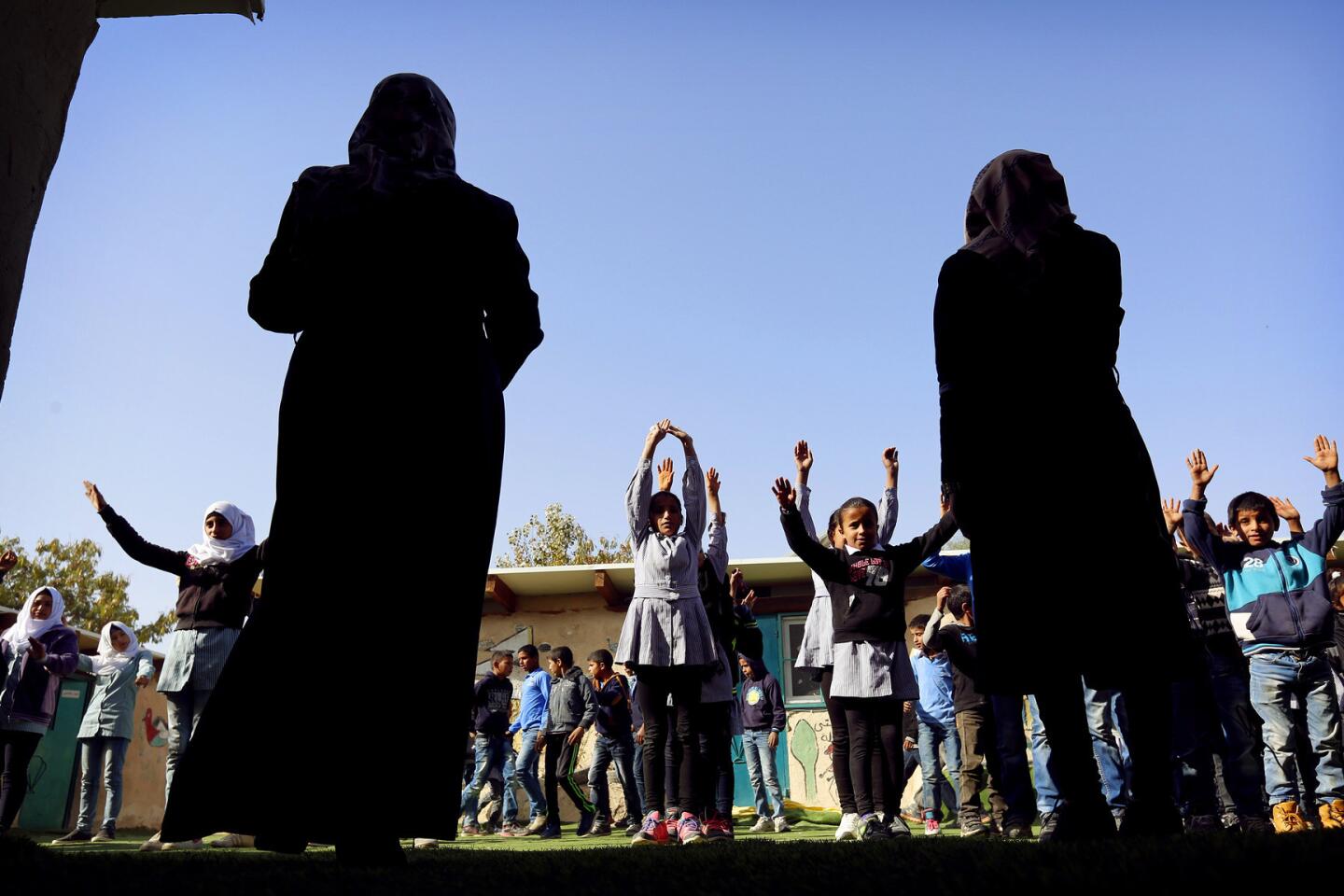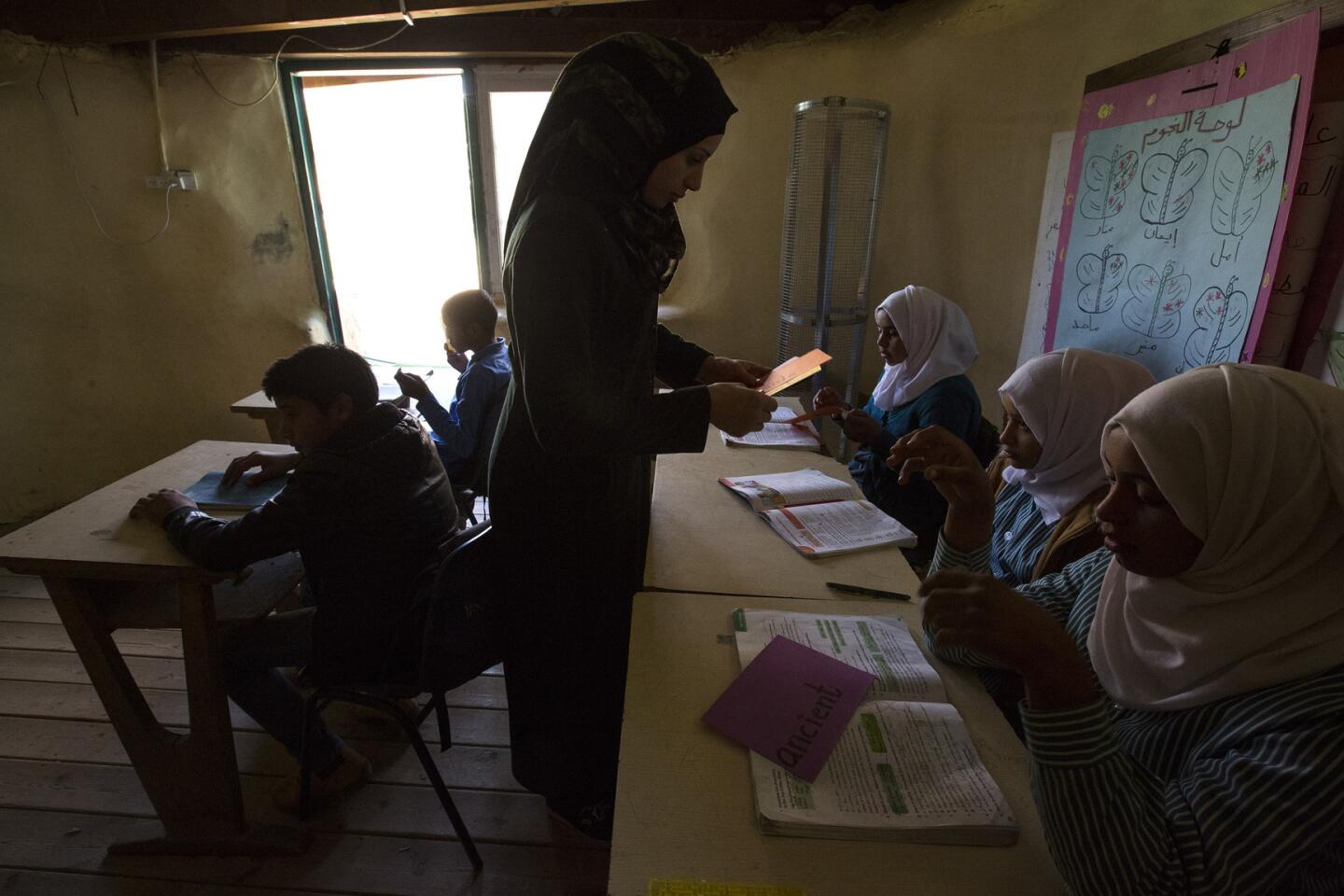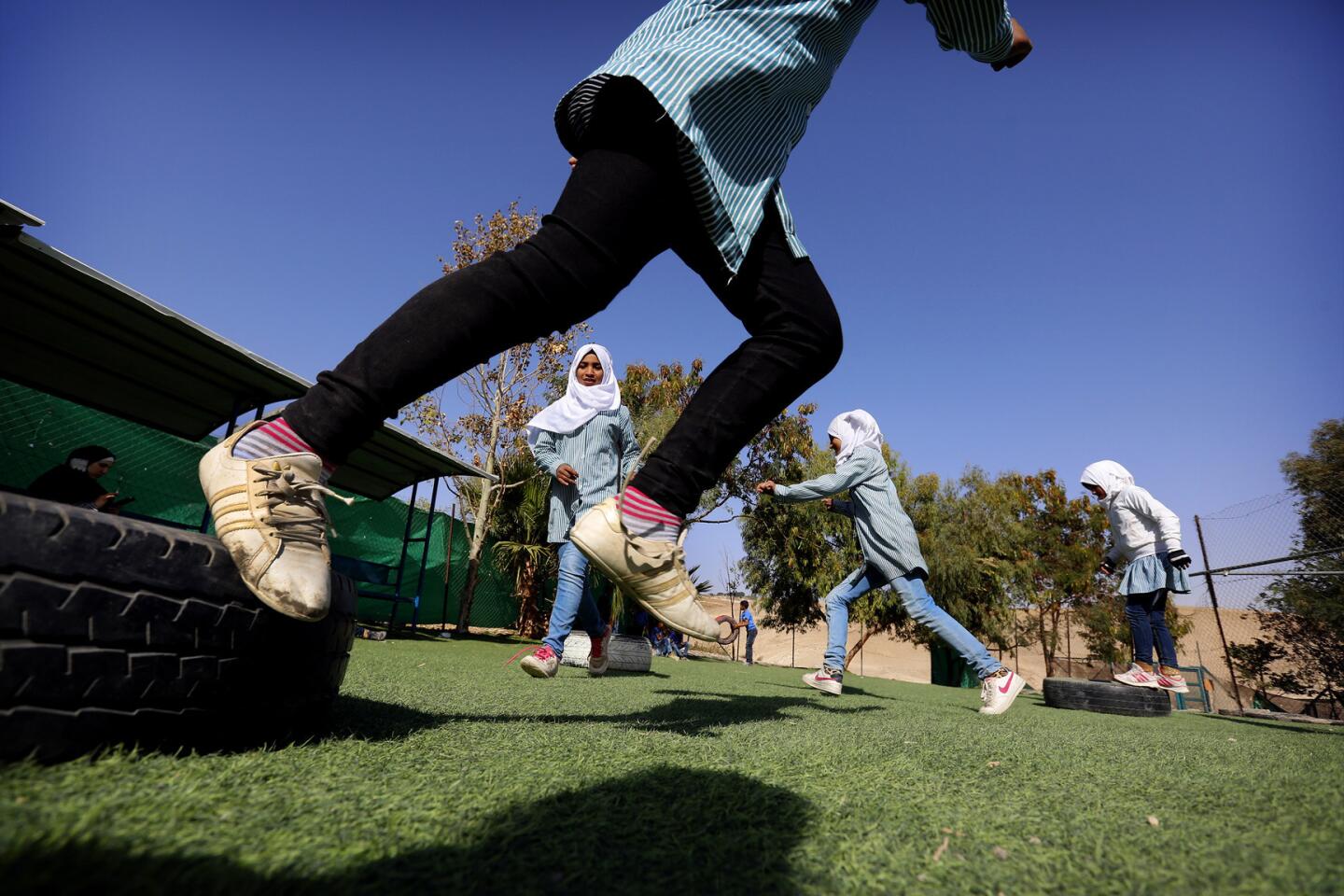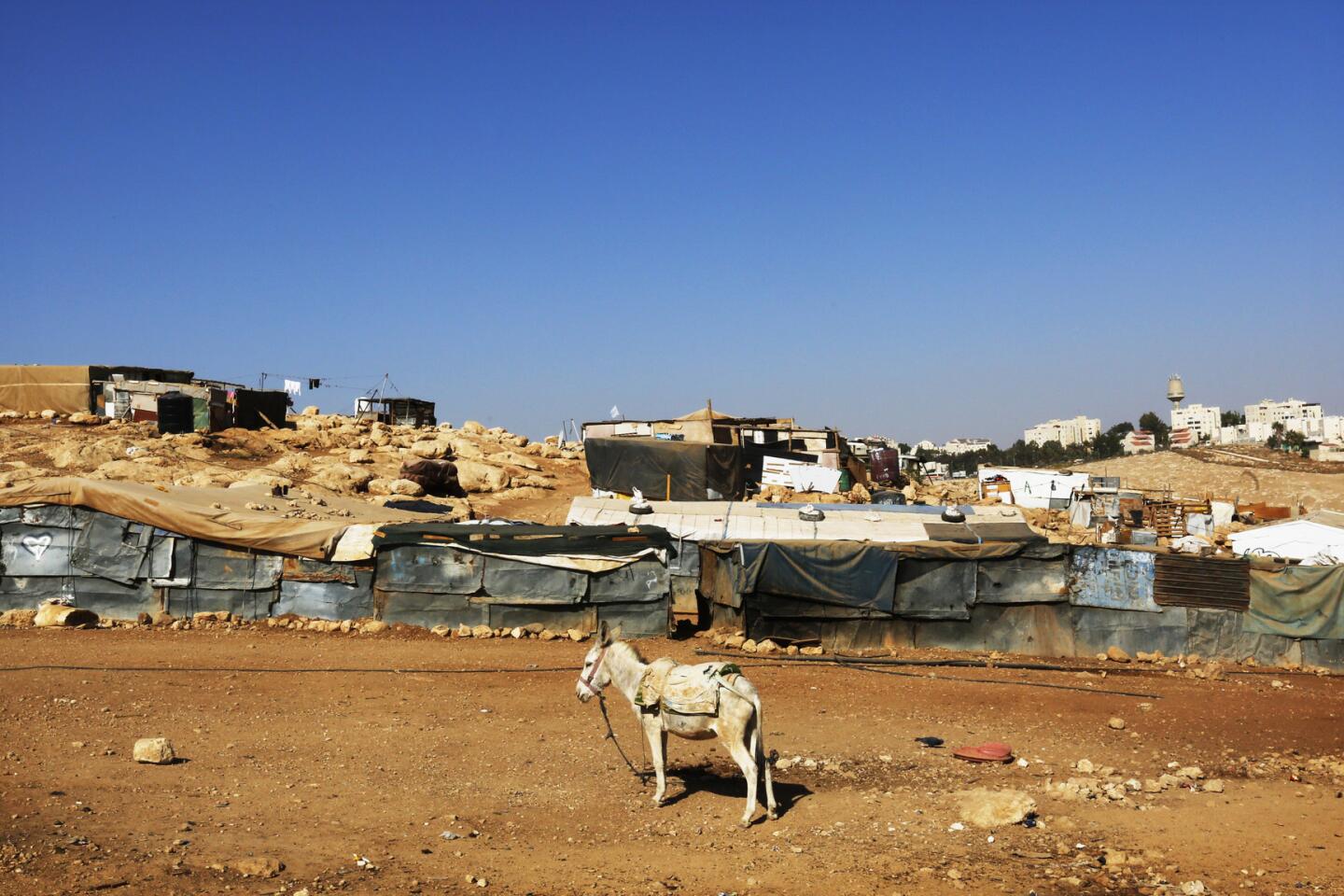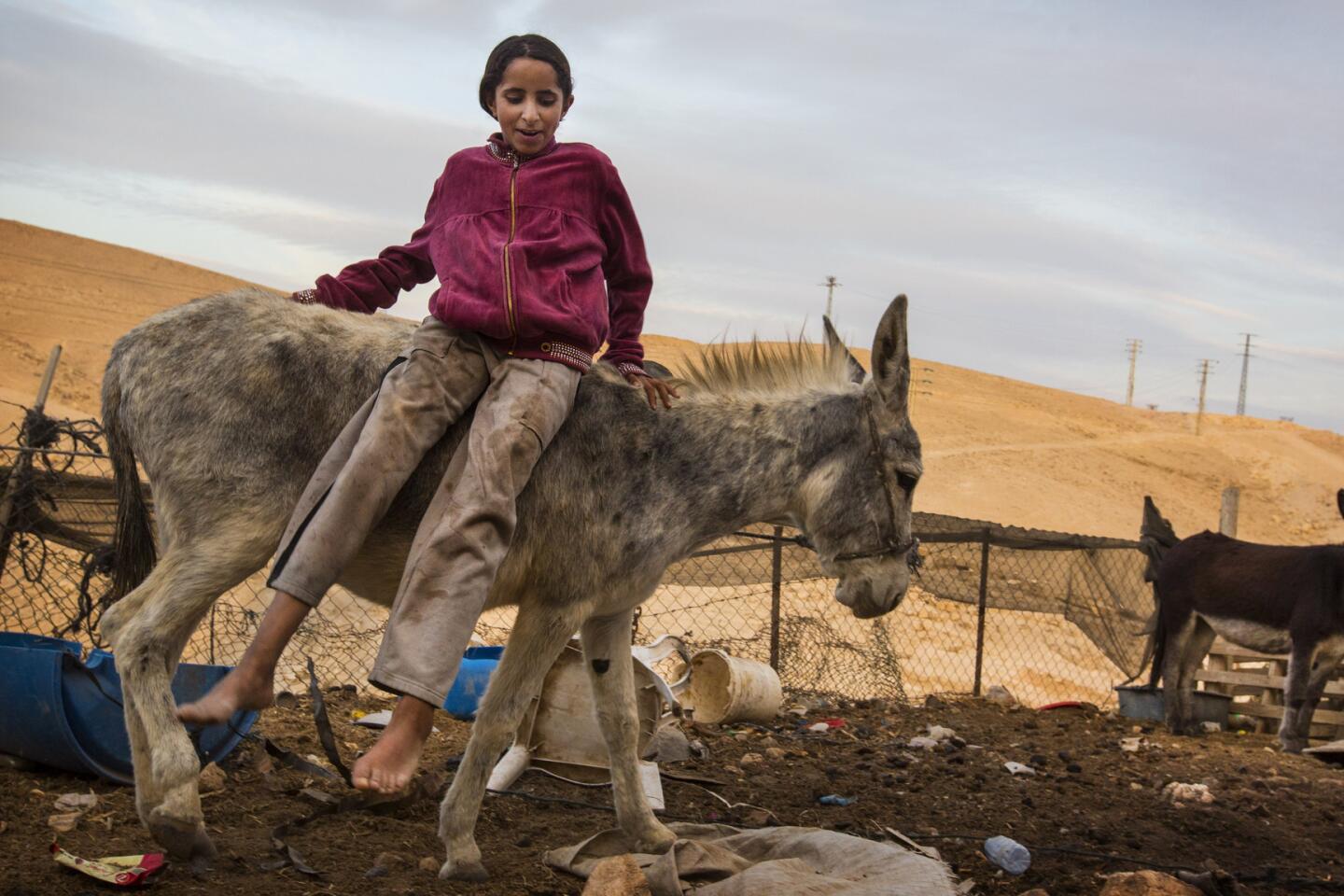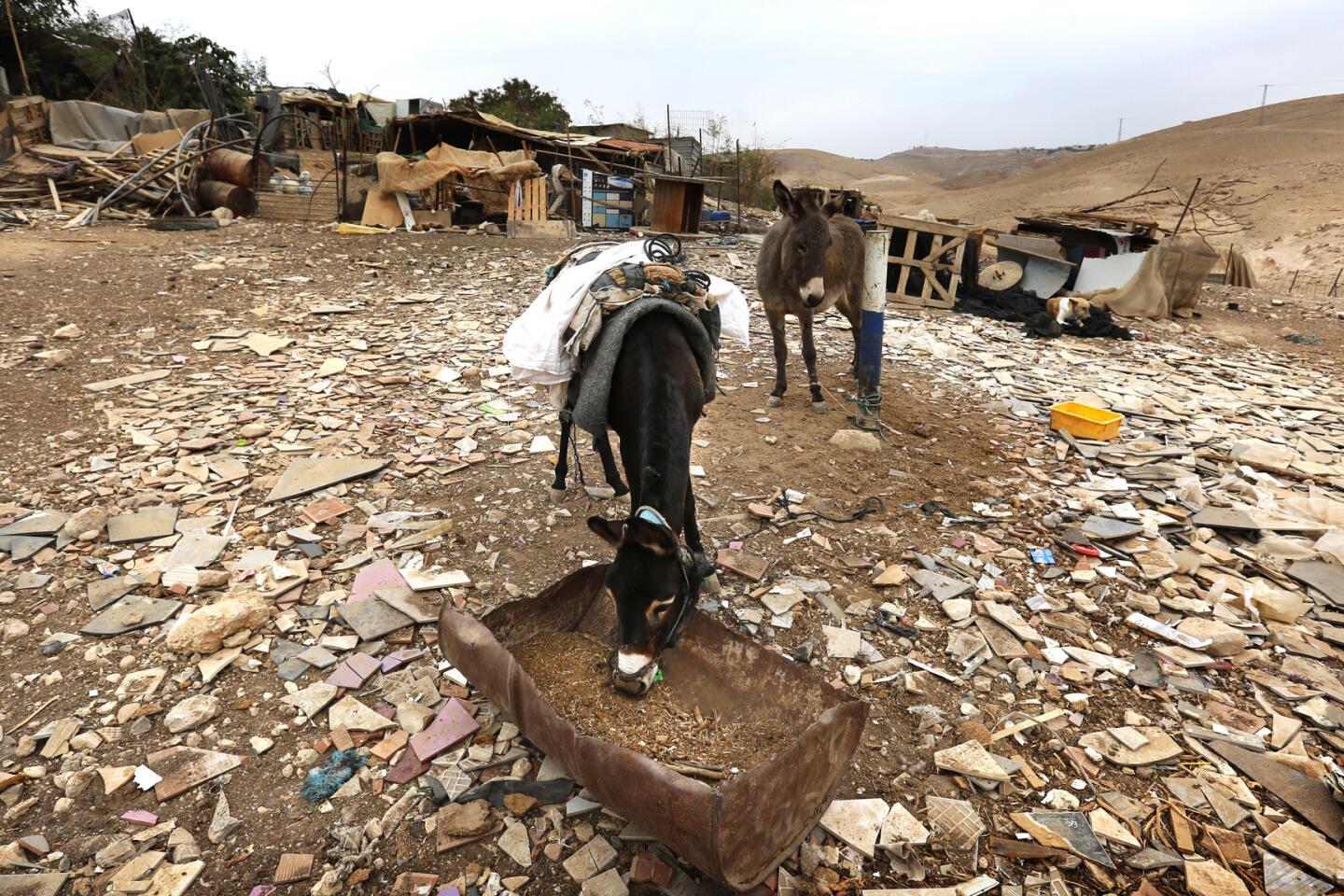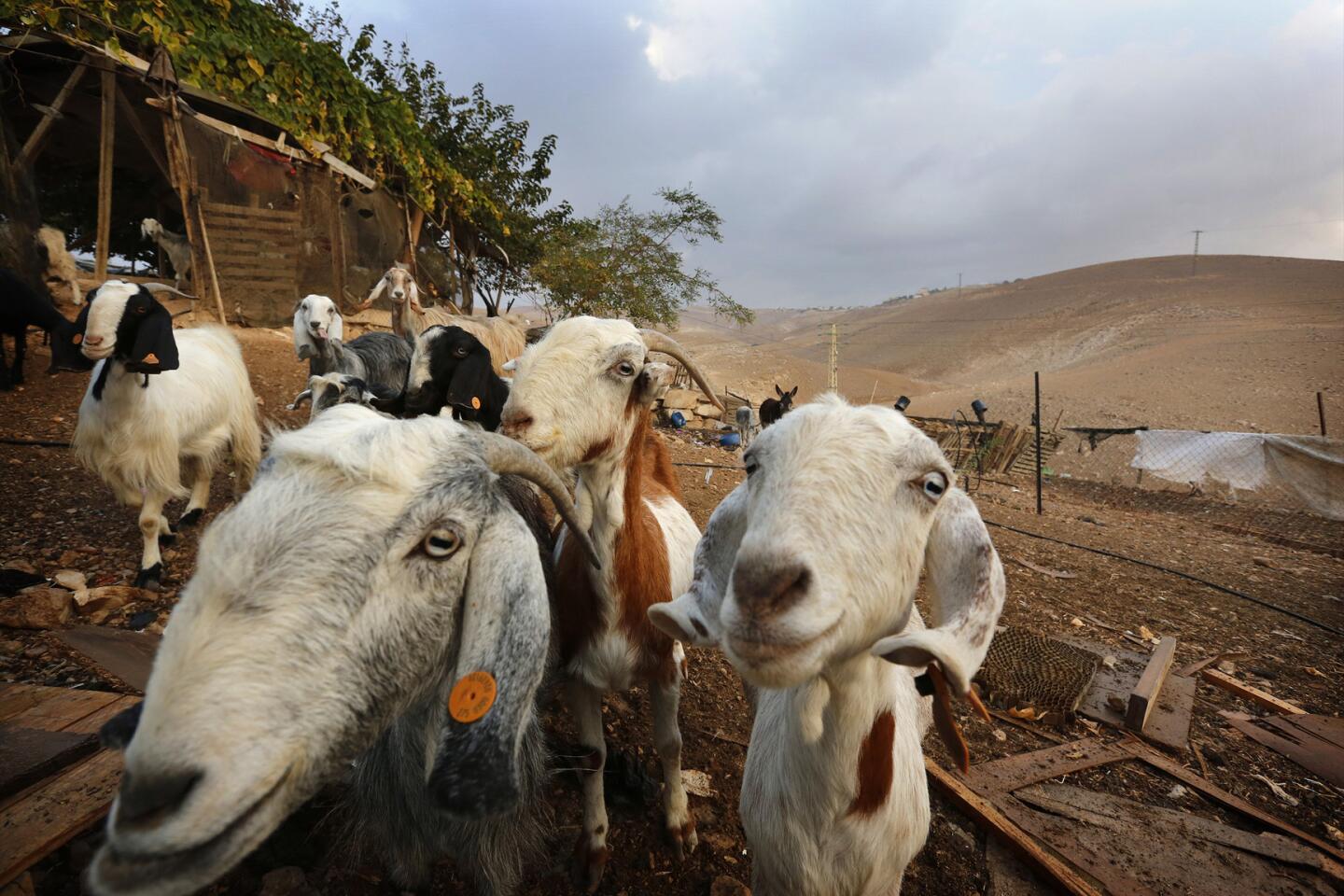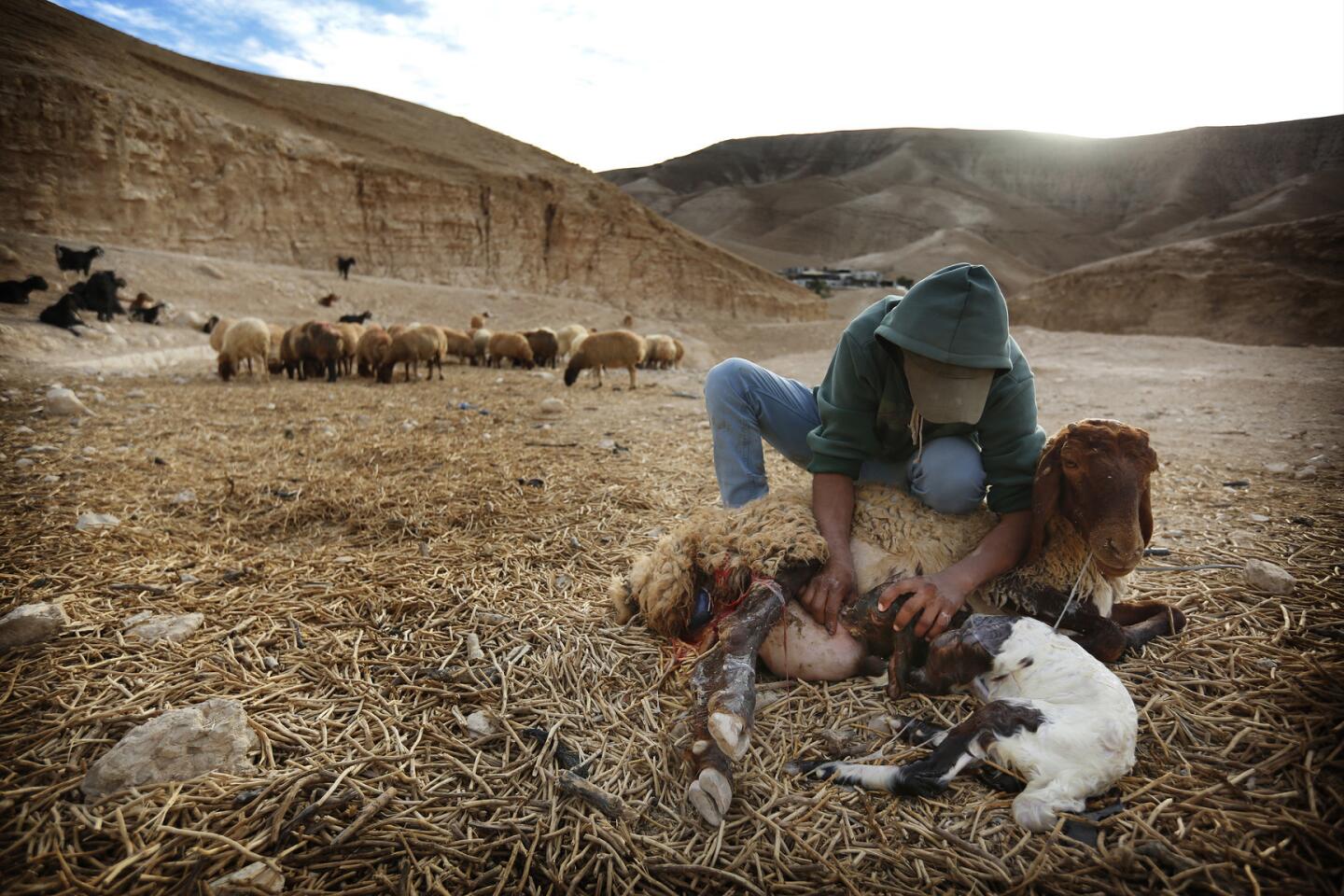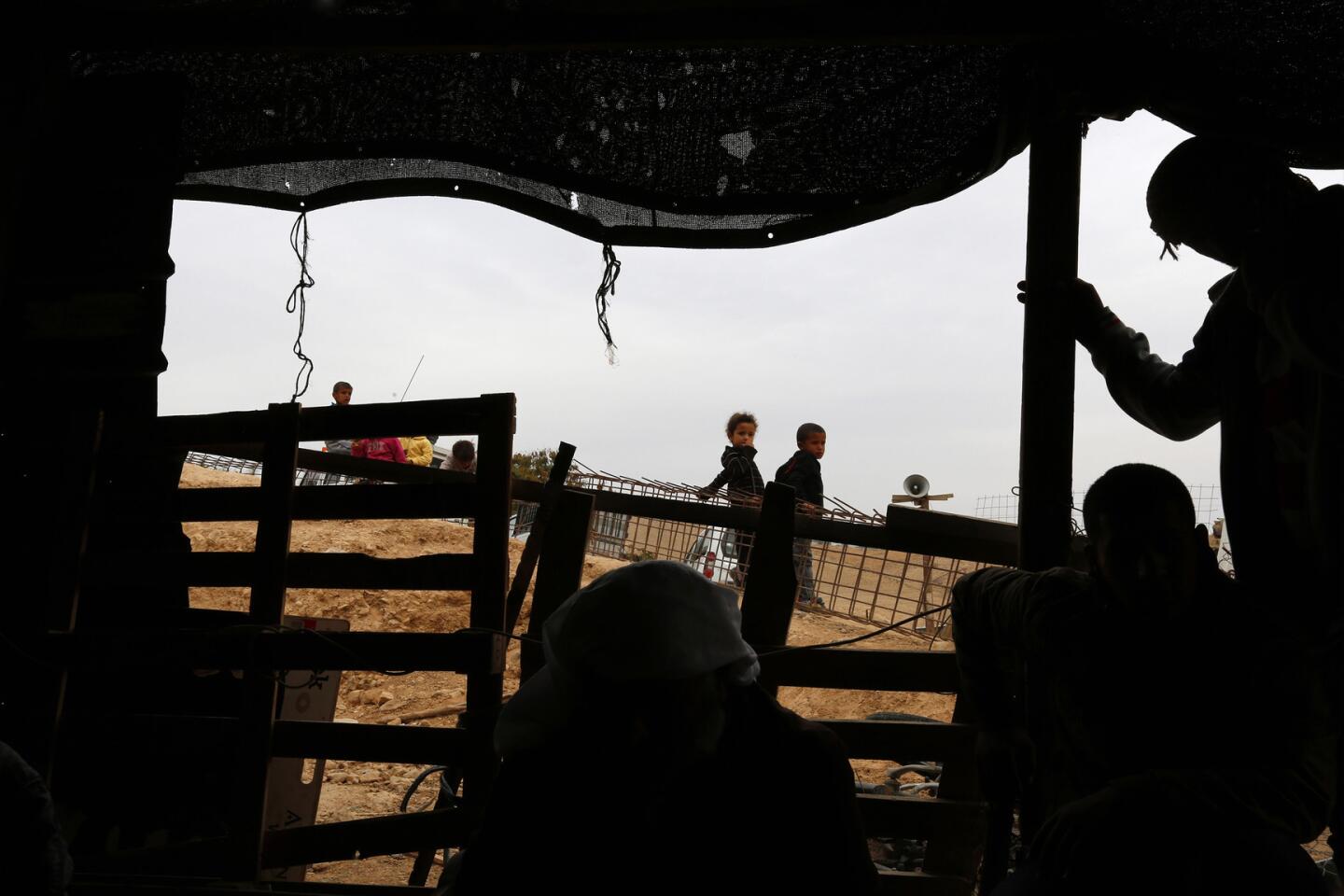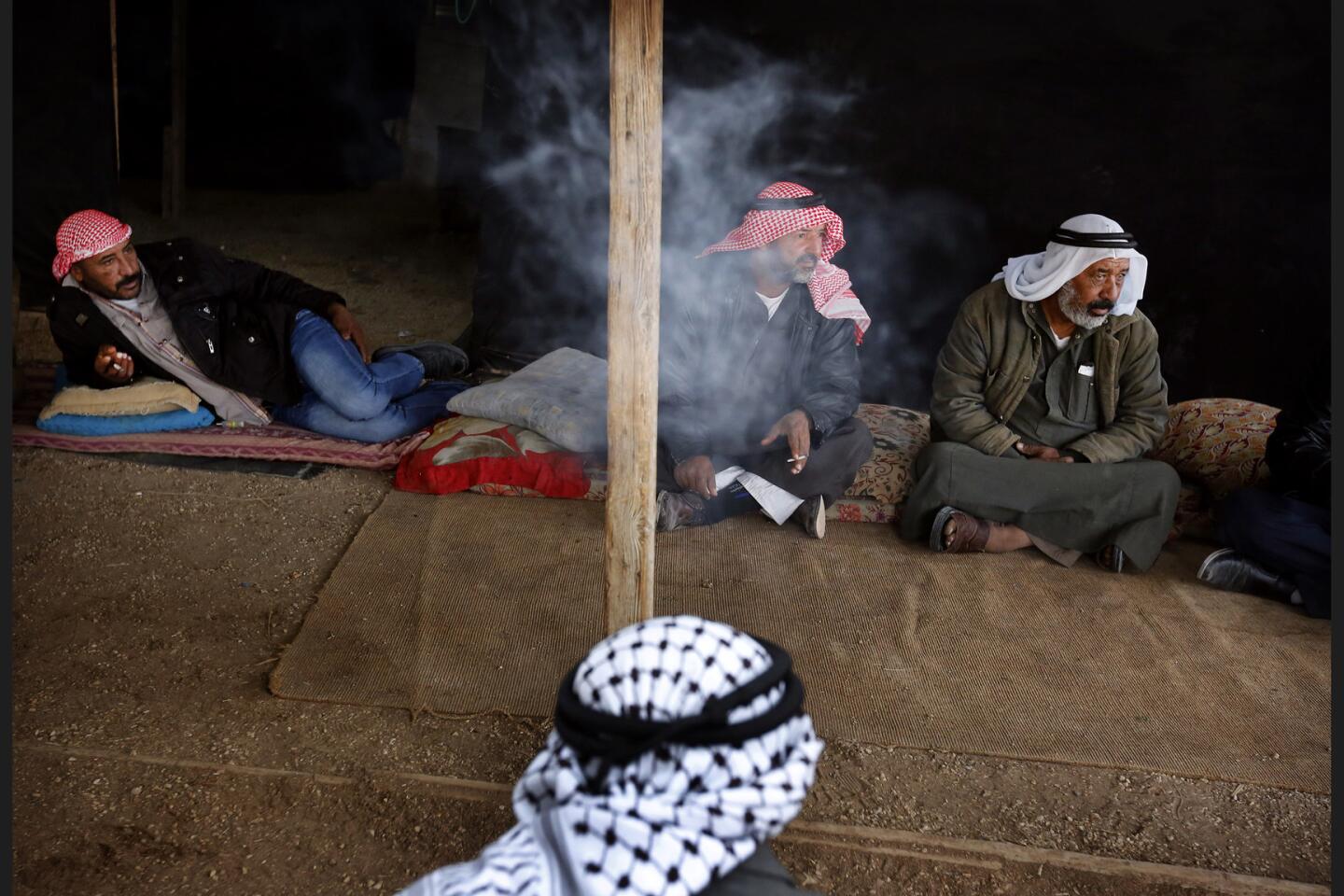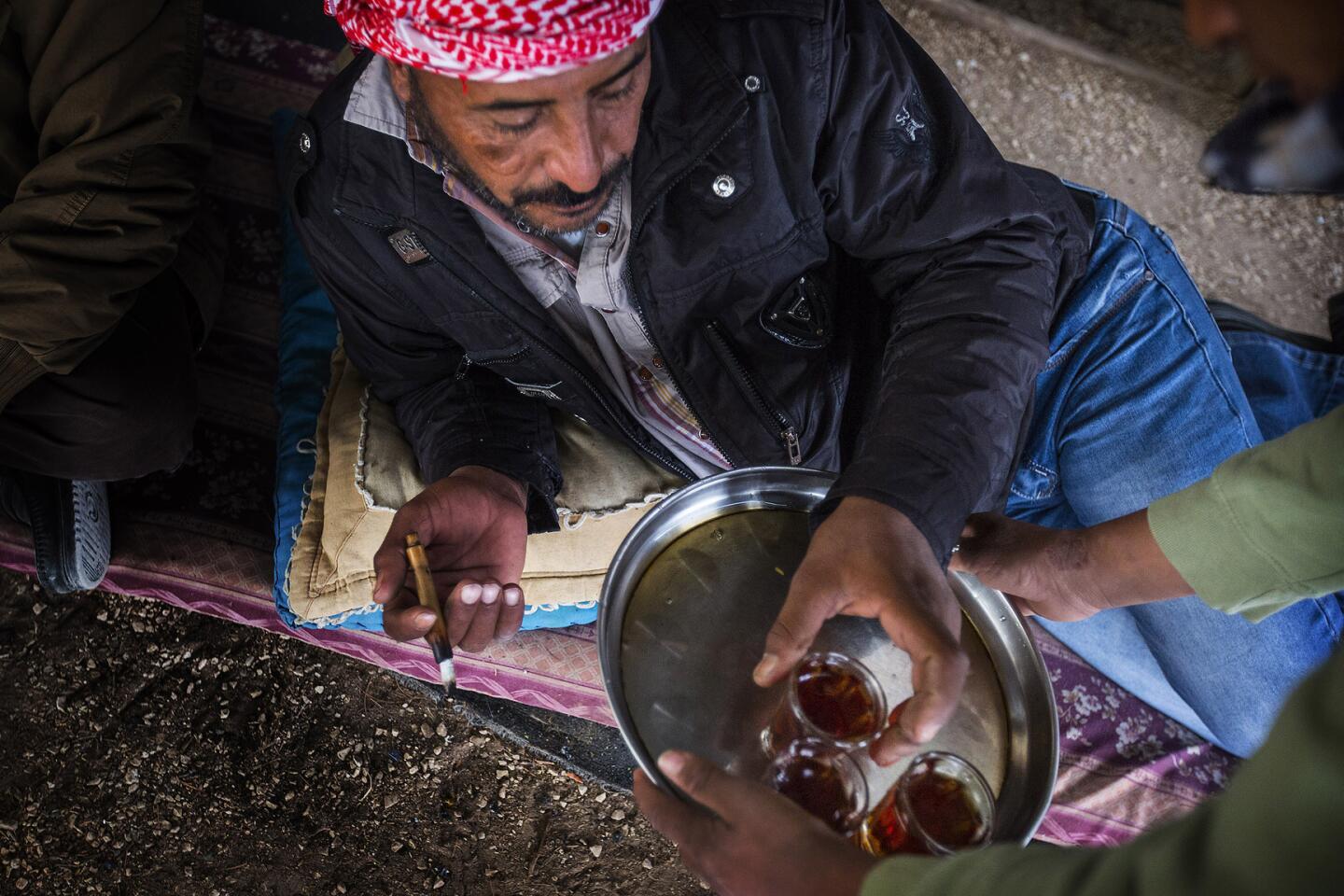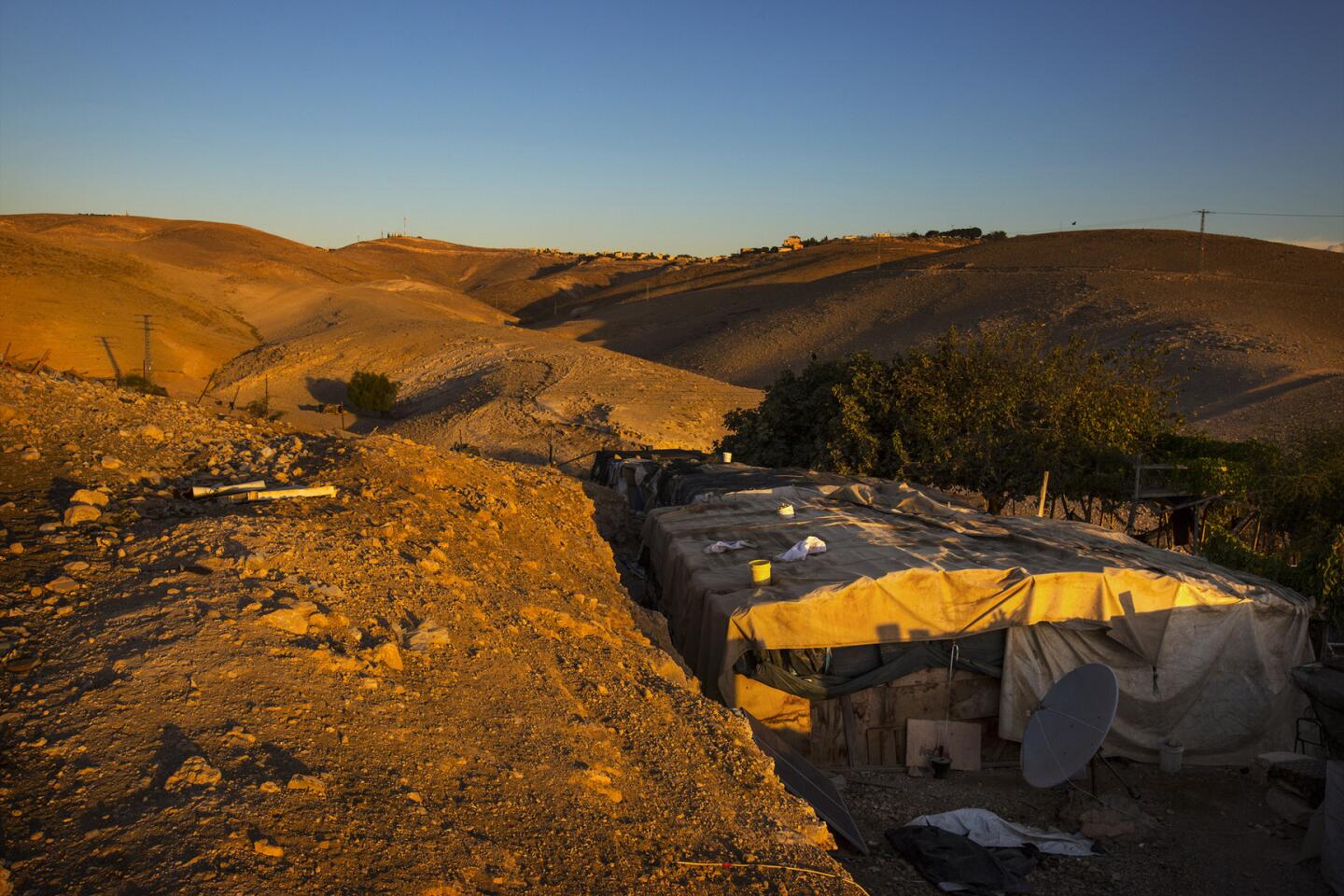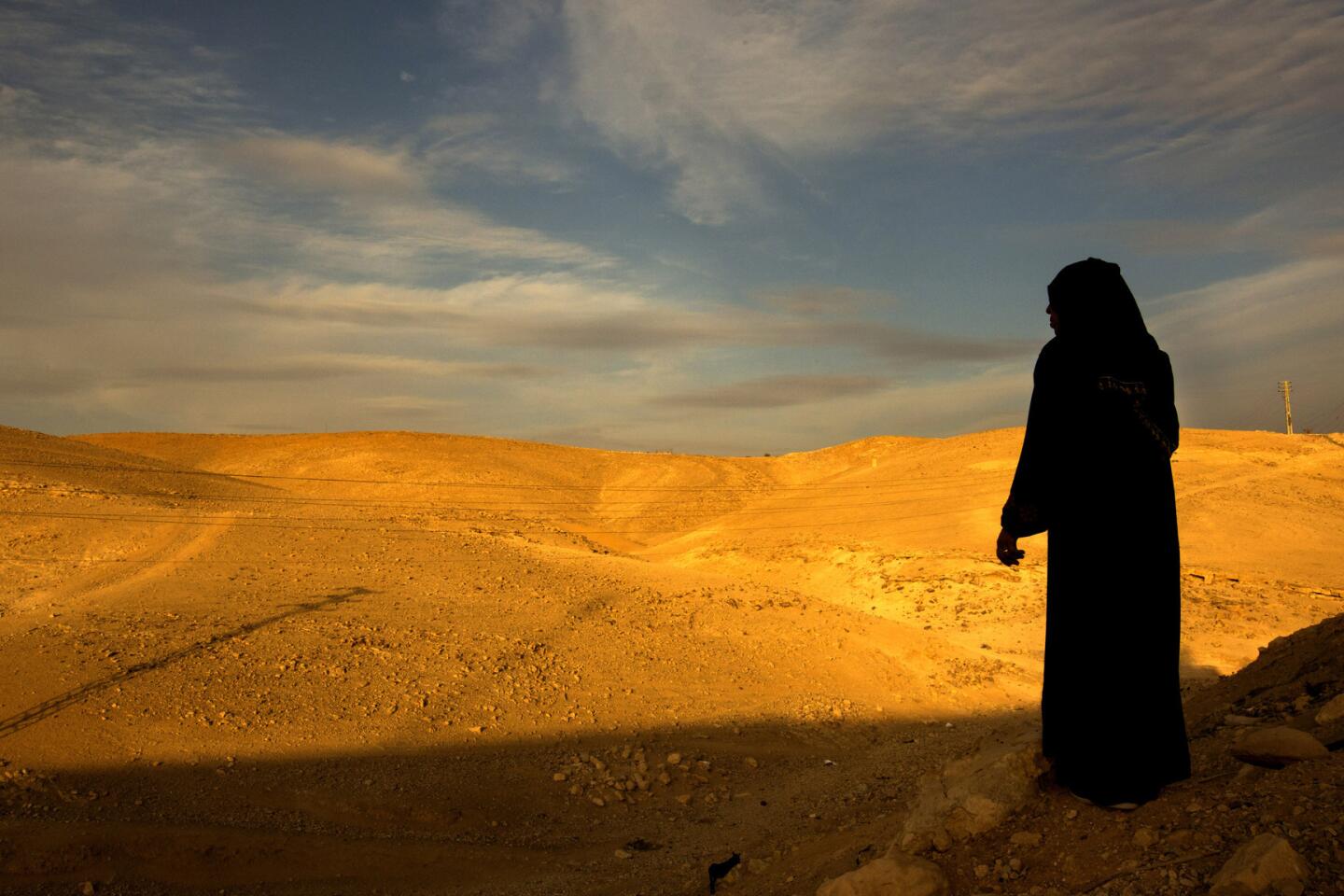Bedouins in the West Bank hold fast to their land — as pressure builds for them to leave
- Share via
Reporting from Khan al Ahmar, West Bank — The predawn sky exposes the outlines of the slopes of the Judaean desert. A strip of lamps on a new highway bathes the rocky earth in a ruddy glow, as motorists zip through the lonely expanse toward Jerusalem.
Here amid a chorus of crowing roosters, a cluster of dilapidated shacks on the desert hillside marks a tiny Bedouin encampment known as Khan al Ahmar.
The 160-person outpost, like dozens of other Bedouin hamlets clustered around the roadway, populates a region that descends from the Jerusalem mountains toward the West Bank city of Jericho and the border with Jordan.
It is a rugged, sparse landscape — but one that is at the center of a political tug of war. The region is coveted by Israelis who want to expand Jewish settlements and to solidify control over Jerusalem, as well as Palestinians who see it as part of their own state someday.
The Bedouins, caught in the middle, may soon be forced from this land.
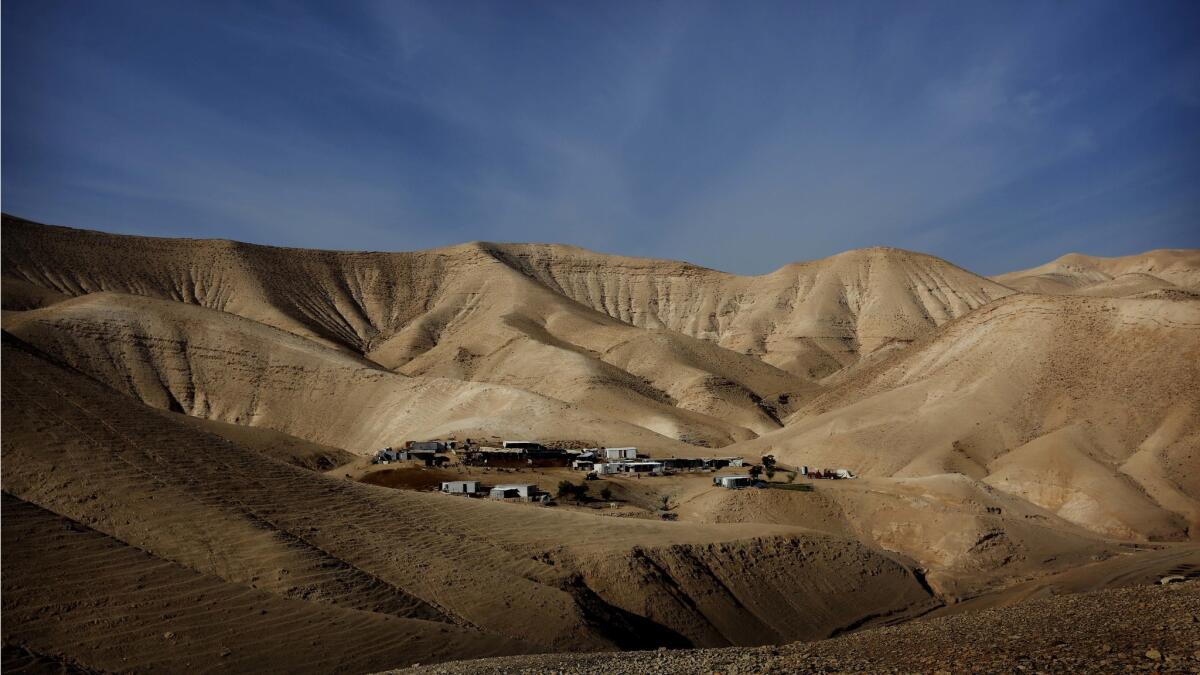
In one home open to the chilly morning air, members of the Abu Dahouk family were wrapped in blankets as they began to stir shortly after 6, rising from mattresses set on large rugs covering the desert floor of rock and dirt.
In a shack that serves as the family kitchen and dining room, 12-year-old Nasrin and 14-year-old Iman, the two youngest in the family of nine, knelt over a fire tended by their mother, Sara. Their father, Eid Abu Dahouk, offered the young girls some spare change before they left for school.
The family’s flock of sheep and goats needed grazing, but for the father, known to most by his nickname, Abu Khamis, the next order of business was meeting with European diplomats.
An affable envoy representing an insular community, Abu Khamis served the diplomats sweet tea and pita bread prepared by his wife. He briefed them on an upsurge in home demolitions by Israeli military authorities.
Foreigners, diplomats and human rights workers are frequent guests here because the encampment — illegal under Israel’s military occupation — sits on such a strategic fault line of the Israeli-Palestinian conflict.
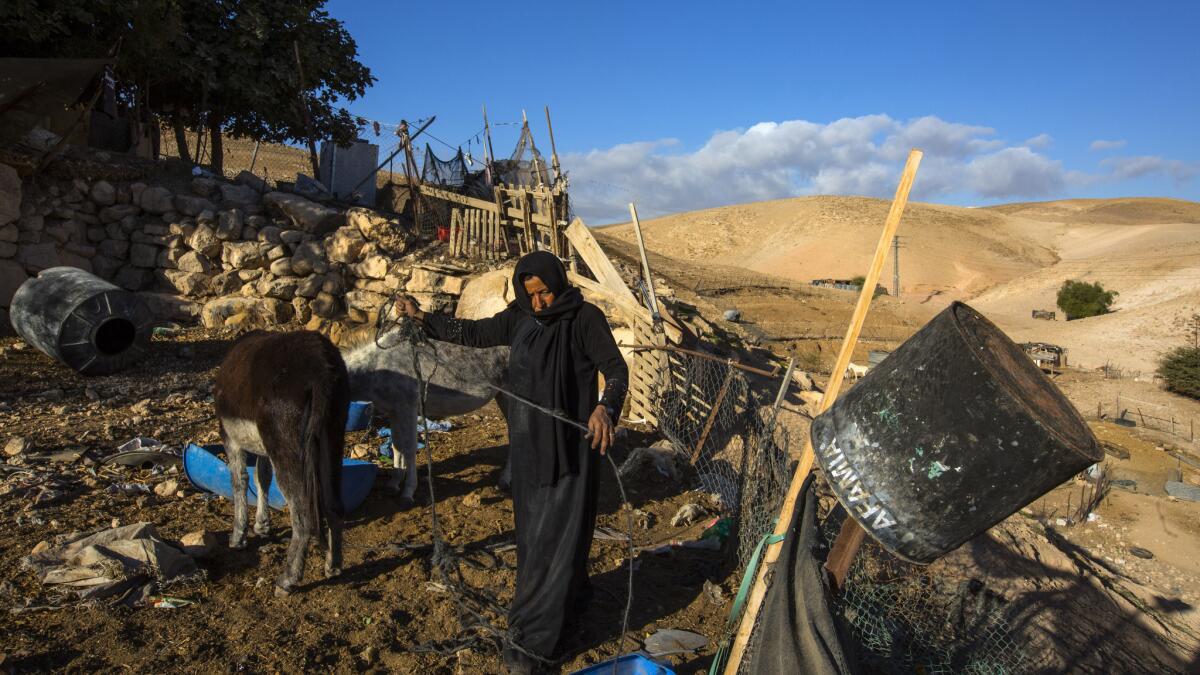
Displaced to the West Bank from ancestral lands after Israel gained independence in 1948, the Jahalin tribes settled in the open area outside Jerusalem with their flocks of sheep and goats. Some families live less than a mile from one another while others live two or three miles from the nearest neighbor.
The Bedouin here are registered with the United Nations as Palestinian refugees. But they live apart from Palestinian society, and Abu Khamis complains that the Palestinian government in nearby Ramallah hasn’t made good on promises to provide school transportation for the children.
The Abu Dahouk family lives in a row of partially open shacks made of wood beams, corrugated metal and canvas. One day recently, a wisp of smoke rose from the entry to a soot-blackened kitchen where the family prepared lentil porridge over an open fire. At the end of the row, a lone acacia tree overlooked the cottages of a tiny Israeli settlement, Kfar Adumim, sitting on a ridge about a half mile in the distance.
Foreign-funded solar panels helped power a medium-sized flat-screen television mounted alongside couches in a shack that doubled as sleeping quarters and a common area to host visitors.
Abu Khamis, 50, said the family prefers to stay at Khan al Ahmar despite the pressure to relocate.
“What I really want is to remain where we are now,’’ he said. “Why not build for us a community or village right here? Why take us somewhere else?’’
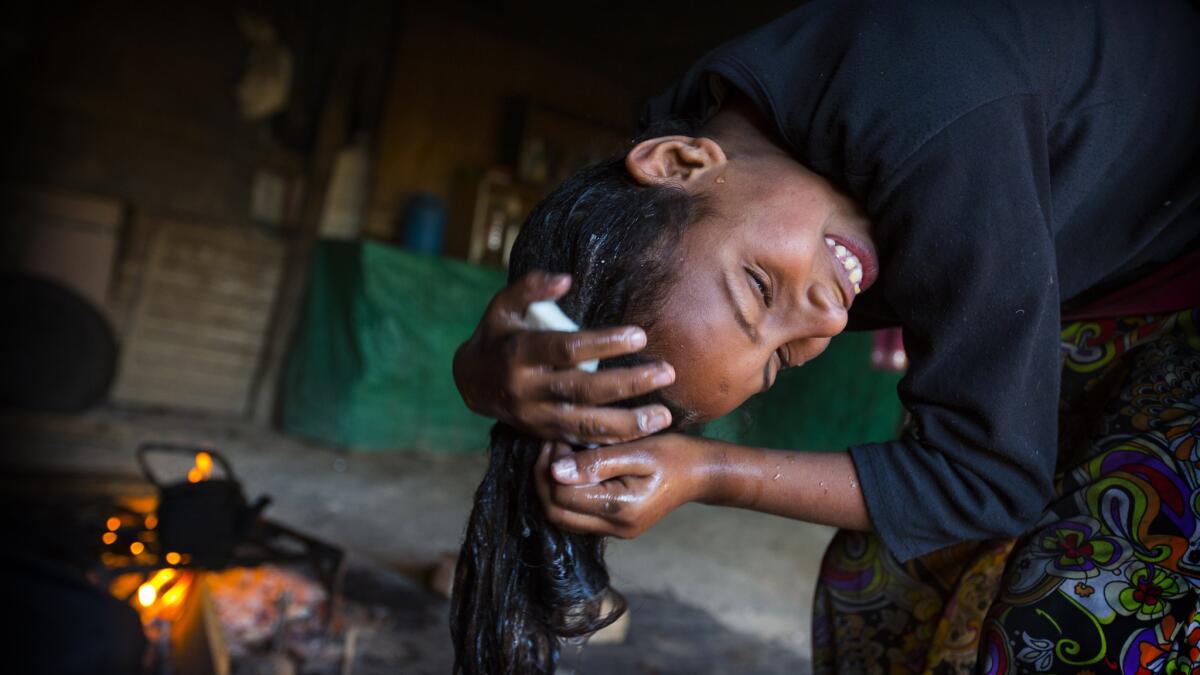
As the rising morning sun colors the desert a burnt orange, outlines of uniformed school children appear on a nearby hilltop above Abu Khamis’ home. One by one and in pairs, they come skipping down toward a fenced off enclave of single-floor rooms constructed of mud and tires, the Khan al Ahmar elementary school.
Nicknamed “the tire school,” it is a hive of activity and noise in an otherwise sleepy encampment. At recess, shouting students raced in between classrooms and kicked a soccer ball on a playground of artificial grass. Many of the 160 pupils make daily treks through the desert hills of up to two miles from homes in nearby encampments.
Children learn English, math, Arabic and geography in tiny classrooms whose facades are decorated with murals of doves and Palestinian flags.
Before the school was built in 2009, the Bedouin children would have to cross the highway to catch rides to schools in Jerusalem or Jericho. Some of the children died in highway accidents.
“They really love to come here. They really want to study and keep the school clean. They suffered from not having a school,’’ said Halaime Zahaikah, a science teacher from Jerusalem. “It’s a place where they can play and have fun.’’
The school, built with the help of foreign and Israeli human rights activists, has become a symbol of the Bedouin struggle to remain in the hills. So far, it has survived several court petitions sponsored by residents from the Kfar Adumim settlement calling for its demolition.
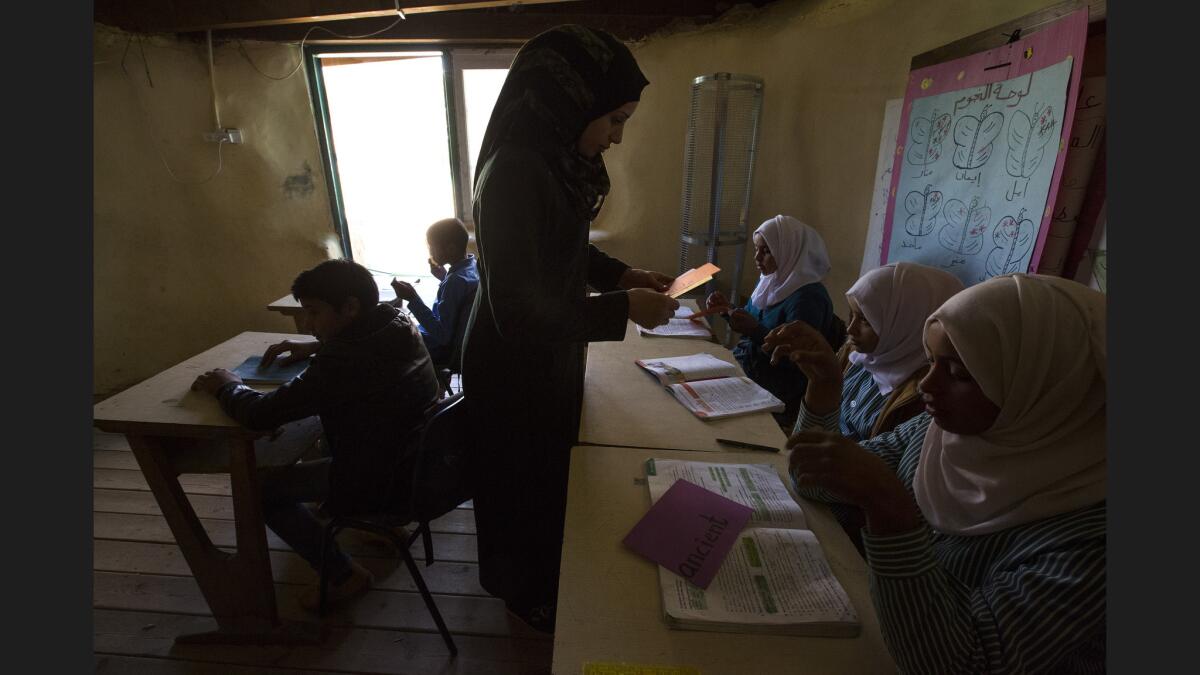
“An elementary school is different from a home,” said Yehiel Grenimann, an activist from the Israeli group, Rabbis for Human Rights, which helped build the school. “A school represents life and hope” for the community.
The Israeli military’s Civil Administration said it is offering the Bedouin properties in West Bank neighborhoods outside of Jerusalem and Jericho where, the Israeli officials say, they will be able to preserve their customs, own a home, and get hooked up to water and electricity. Most have refused the offer.
“Before we built this neighborhood, there were Bedouins. Then the Civil Administration gave them land,” said Maale Adumim Mayor Benny Kashriel, who dismissed the suggestion that Israel is forcing the Bedouin out and that relocating them to make way for settlement endangers a Palestinian state.
“The ones putting pressure on them is the Palestinian Authority — because it prefers that they remain where they are in poor conditions: in tents, shacks, without electricity or water.”
At the entrance of Khan al Ahmar, barefoot toddlers with unwashed faces and tattered clothes greeted visitors. Women, many dressed in long dresses and head scarves, shielded their faces from strangers. Not far away from the children, men from Khan al Ahmar and nearby encampments sat on a carpet outside a public meeting shack in a cloud of tobacco smoke, discussing recent demolitions.
They were awaiting the arrival of a shipment from the World Food Program. Soon, two trucks roared up the unpaved road to the encampment loaded with giant sacks of wheat flour, bottles of cooking oil and lentils to supplement the residents’ food supply.
The Bedouin encampments can appear as if discarded amid the wilderness of the Judean desert. Strewn about the hamlets are junked cars, shipping pallets, canvas and sheets of corrugated metal. Sheep and goat pens are built from wood planks and chain-link fencing.
There is, however, a logic behind the location, said Abu Khamis. The Bedouin can persist if they have access to a highway to bring their livestock, milk and yogurt to cities, a nearby water source, and room for their goats to graze, he said.
But over time, the grazing areas have shrunk substantially amid the expansion of nearby settlements, the construction of Israel’s separation barrier in the West Bank, and the closing off of land for military training zones.
Abu Khamis said the head count of livestock dropped about 75% in the last 20 years, while the East Jerusalem-based International Peace and Cooperation Center estimated it dropped about 33% during that time. To make up for the lost income, most of the men work outside of the encampments in nearby Jewish settlements or in agriculture plantations in the valley around Jericho. For many years, Abu Khamis drove a bulldozer that helped build Kfar Adumim.
In an encampment about two miles from Khan al Ahmar, Khalil Mohammed Jahalin kneeled over a pot of tea and recalled how he and his family awoke two days before to bulldozers and an Israeli official with a demolition order.
“It hurts that, in a place that’s yours, the place where you live is being destroyed, and they’re making a mess out of it. They don’t want the Bedouin here. And in another 10 or 20 years, you’ll see [settlement] buildings. What kind of a country is this? What kind of a life is this?”
Back at Khan al Ahmar, a gentle winter rain fell on the roof of Abu Khamis’ shacks as the afternoon sun grew weak and the winds picked up. After returning from school, the girls played games, and stared at cartoons on the family TV until they were shooed away by an older brother.
With the help of the children, Abu Khamis’ wife, Sara, prepared a pot of lentils and fresh pita bread for an early dinner. As the family warmed itself by the fire, Abu Khamis said that he hoped his young daughters will continue their education at a university when they get older. Whether the encampment will still be in the same place for the children to return to, he can’t say. Representatives of the Israeli military visit regularly to remind him eventually Israel will force the Jahalin to leave Khan al Ahmar.
He recalled a conversation with an Israeli official, who told him: “Sooner or later you will be evacuated.”
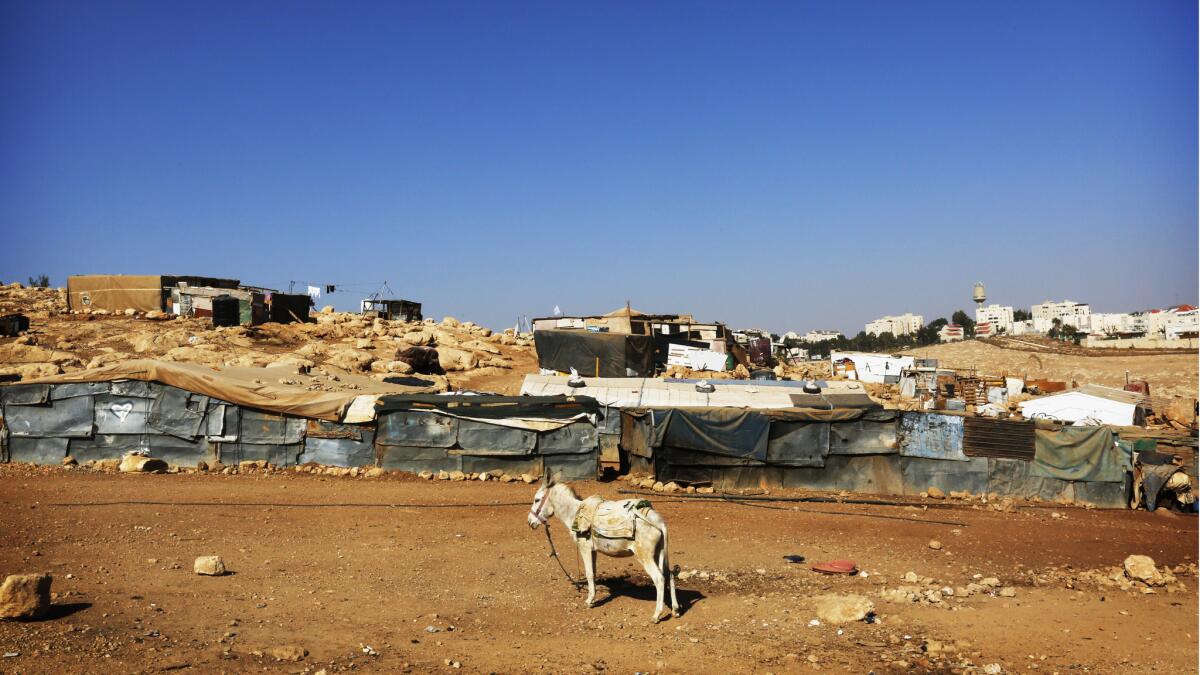
“All Bedouin communities from Jerusalem to the Dead Sea are under a demolition order,” Abu Khamis told the visitors.
In February, the prospect of displacement seemed to become more imminent at Khan al Ahmar after Israeli authorities marked several dozen homes and structures for demolition. The move is being challenged by human rights lawyers and is expected to be heard by Israel’s High Court of Justice in September.
Many Palestinians and rights activists worry that evicting the Bedouins to make way for settlement growth would create an Israeli wedge between the northern and southern West Bank, making the creation of a contiguous Palestinian state physically impossible.
Meanwhile, there has been growing pressure within Israel’s coalition government to annex Maale Adumim, a settlement east of Jerusalem with a population of about 38,000, whose enormous boundaries nearly ensconce all of the Jahalin Bedouin.
“There is no way to have a Palestinian state with Israel controlling this area,” Abu Khamis said. “If Israel evacuates the Bedouin community from this area, the boundary of Jerusalem will be extended to the Dead Sea. It will be the end of the last hope for peace.”
Abu Khamis’ family is among about 7,000 Bedouins from the Jahalin tribe who claim the Judean desert slopes east of Jerusalem as their home and cling to the remnants of their lives as semi-nomadic herders.
About 30 Bedouin encampments, each one measuring just a few acres, sit on rocky slopes nearly empty of trees or vegetation.
Mitnick is a special correspondent.
ALSO
Islamic State strikes back with female suicide bombers as Iraqi forces advance in Mosul
Arab nations extend deadline in Qatar crisis by 48 hours
Vice President Mike Pence stays loyal to Trump, but it could come at a cost
More to Read
Sign up for Essential California
The most important California stories and recommendations in your inbox every morning.
You may occasionally receive promotional content from the Los Angeles Times.
